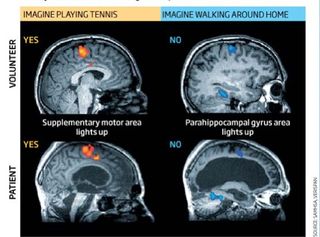 File this one under “Dr. Frankenstein’s Medicine Show.”
File this one under “Dr. Frankenstein’s Medicine Show.”
Let’s deal with the medicine part first and the Frankenstein part second.
On the medical front, good news! Researchers have found a way to communicate with patients who are in a “persistent vegetative state.”
Turns out that they, or some of them, ain’t so vegetable-like after all!
Here’s how it works: Hook the “vegetable” up to an MRI machine and ask the
vegetable
person to think about playing tennis. Note what areas of the brain light up.
Then ask the person to think about walking through their house. Note what areas light up then.
Then say, “I’d like to ask you some questions. If you want to answer ‘yes,’ think about playing tennis. If you want to answer ‘no,’ think about walking through their house. Do you understand?”
If the tennis-playing areas light up, go ahead and ask your questions. If the house-walking areas light up, explain again. (Or assume that the person is really smart and having a joke on you by thinking “no” when really he does understand.)
This really works!
At least with some patients. (Not with others, unfortunately.)
What it shows, though, is that these patients aren’t “vegetative” at all—at least mentally. They’re able to process and respond meaningfully to questions based on thinking about remembered/imagined actions.
That shows advanced cognitive functions! Remember: The person isn’t just thinking about saying “yes” or “no.” The person is thinking about other actions as a way of saying “yes” and “no.” That shows sophisticated mental processes in action!
So! Good news for the pro-life side, right?
Yesssss . . . but . . . here’s where Dr. Frankenstein—or at least Dr. Kevorkian—comes into the picture.
Already people are talking about using this technology to ask PVS patients questions like “Are you in pain?” and “Do you want to die?”
The first question is entirely legitimate! If someone’s in pain, let’s do what we can to alleviate it! By all means!
But let’s not proceed so quickly to the “Do you want to die?” question.
Other questions would be good ones, like “Do you need to change positions?”, “Are you hungry or thirsty?”, or “Would you like me to get a nurse?” or—once the immediate pain is dealt with—“Would you like me to get a priest to come pray with you and give you the sacraments?”, “May I squeeze your hand to show that I care about you?” (or even just do this one and don’t ask!), “Would you like me to turn the TV on?”, “Would you like to listen to some music?”, “How about an audio book? I could get you a subscription to Audible.com.” Or even, “Let’s use ‘yes’/‘no’ with the alphabet so you can tell me what you want. Think about what you’d most like, and we’ll spell it out.”
There are all kinds of compassionate alternatives to “Do you want to die?”
But folks are already noting that the new technique may put more pressure on people suffering from PVS to just go ahead and die.
So what can—and by rights should—be a vindication for pro-lifers may get twisted into a new way to promote euthanasia.
Hence: Dr. Frankenstein’s Medicine Show. . . . turning legitimate medicine to the service of evil.
Watch this one, folks. It’s going to be a BIG one as brain scanning technology becomes more common and more robust—allowing easier, richer communication with people in this state. It’ll be a major new feature of the discussion.
The work “changes everything”, says Nicholas Schiff, a neurologist at Weill Cornell Medical College in New York, who is carrying out similar work on patients with consciousness disorders. “Knowing that someone could persist in a state like this and not show evidence of the fact that they can answer yes/no questions should be extremely disturbing to our clinical practice.”



